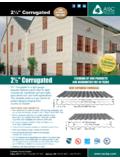Transcription of FEFCO RECOMMENDATION N°. 101 (July 2006)
1 Revised version of original dated 2002 FEFCO RECOMMENDATION N . 101 (July 2006) PROCEDURE FOR DETERMINING THE INTERNAL DIMENSIONS OF THE FLAP TYPE OR ONE PIECE CORRUGATED BOARD CASES. This FEFCO RECOMMENDATION is one of a series numbered from 101 upwards, which gives guidance to FEFCO Members appropriate to the issue as described in the title, in practical matters dealing with production, or customer-related problems. It is hoped that it will provide a uniform means of operation, for example in a comparative study of a problem. The issuing body is the FEFCO Standards Committee working under the auspices of the FEFCO Board. The FEFCO Recommendations are supplementary to the internationally recognized FEFCO Testing Methods. The latter will continue to be developed for testing corrugated board products. 1. OBJECTIVE: To define a method to be used in order to determine the internal dimensions of corrugated cases.
2 2. SCOPE: The procedure is intended to apply mainly to the flap type cases illustrated as Style 0201 in the FEFCO /ESBO CASE CODE, but can be used for other styles, where it is appropriate. 3. PRINCIPLE: Distances between crease (score) centers on cases in the flat are measured and from these the applicable creasing (scoring) allowances are subtracted to obtain the internal dimensions. 4. DEFINITIONS: Internal dimensions are usually expressed as Length (L), Breadth (B), and Height (H), in that sequence. These are defined in relation to the sides, ends and top/bottom of a case as follows: Revised version of original dated 2002 Length The longer dimension at the opening Breadth The shorter dimension at the opening Height The dimension from the top of the opening to the base. Side The panel of a case defined by the Length (L) and Height (H) dimensions.
3 End The panel of a case defined by the Breadth (B) and Height (H) dimensions. Top/Bottom The upper or lower surfaces of a case defined by the Length (L) and Breadth (B) dimensions. Crease (Score) The indentation in corrugated board to facilitate folding or bending. Creasing allowance The amount added by the designer to obtain a specified, required dimension when board is bent or folded into a desired configuration. ( Material grade, flute form and case style are some of the factors which influence the amount allowed). 5. APPARATUS: A rigid or flexible rule or measure made of suitable non-stretch material and of a suitable length graduated in one millimeter increment from which the measurements, in mm, can be obtained. 6. PROCEDURE (to obtain internal dimensions): Open up the manufacturers joint of a specimen unused case to give a completely flat blank with the case interior surface uppermost.
4 The Following measurements are to be obtained in the middle of the case blank (see fig. 1): (i) the longer distance between the vertical crease centers (ii) the shorter distance between the vertical crease centers (iii) the distance between the horizontal creases Revised version of original dated 2002 The equivalent distances can be measured elsewhere on the case if necessary. The internal length (L) is the distance described in , minus one thickness of the board, between the vertical creases which demarcate the side panel. The internal breadth (B) is the distance described in , minus one thickness of the board between the vertical creases which demarcate the end panel. The interval height (H) is the distance described in , minus twice the thickness of the board between the horizontal creases which determine the height.
5 7. REPORT Where required or necessary the report shall specify the internal dimensions obtained using this Recommended Procedure. Fig. 1 x x Measure these two panels Bibliography: TAPPI T827 Box Blank Dimensioning






